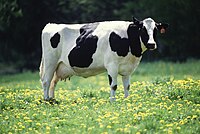
Photo from wikipedia
Barn production systems in Australia are either an indoor-housing floor system or an aviary system with multilevel structures, equipped with nesting boxes, perches and feeding and watering systems. These systems… Click to show full abstract
Barn production systems in Australia are either an indoor-housing floor system or an aviary system with multilevel structures, equipped with nesting boxes, perches and feeding and watering systems. These systems offer hens the freedom of movement and an opportunity to display a repertoire of favourable behaviours as well as interact with complex housing elements as compared with caged systems. However, the system can create prospects for the hens to express detrimental behaviours such as feather pecking and cannibalism. Other aspects of welfare that may be compromised when compared with cage systems include incidence of fractures and injuries during navigation of hens among elements of housing that may result in collision or falls. Barn production systems may have an advantage over free-range production systems in relation to the protection they offer from predators and predator stress, and diseases and parasites that can be contracted from range areas. Barn systems also offer better biosecurity due to lack of direct access to wild birds and their faeces. The aim of the present review is to assess the welfare status of birds housed in barn (and aviary) production systems, while considering husbandry factors that affect welfare outcomes, the health and disease implications and sustainability. To maintain a high welfare outcome in barn production systems, it is important to keep the enclosed environmental conditions optimum by managing air quality, ventilation and lighting within sheds. Sustainability of these production systems depends on consumer preference, cost of production, environmental footprint and suitable genetics of hens.
Journal Title: Animal Production Science
Year Published: 2020
Link to full text (if available)
Share on Social Media: Sign Up to like & get
recommendations!